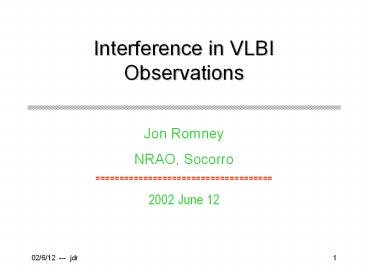Interference in VLBI Observations - PowerPoint PPT Presentation
Title:
Interference in VLBI Observations
Description:
Concept appears in other ITU documents, derived from RA.769 category of VLBI observations. ... Class is Limited (so far) ... to the 10 stations of NRAO's VLBA ... – PowerPoint PPT presentation
Number of Views:28
Avg rating:3.0/5.0
Title: Interference in VLBI Observations
1
Interference in VLBI Observations
- Jon Romney
- NRAO, Socorro
- 2002 June 12
2
Overview
- Background Interferometry
- Background VLBI
- Essential Point Interference Immunity of VLBI
- Examples of Interference in VLBI Observations
- Regulatory Status of VLBI Observations
- Secondary Impact of Interference Calibration
3
Background Interferometry
- Basic Concept
- Synthesis of large aperture by combining signals
from multiple receiving antennas. Spatial
resolution (synthesized beam) determined by
maximum extent of synthesized aperture. - Fundamental Detail
- Signals from individual elements must be delayed
(and phase-shifted) to align desired wavefront
before combination. - Analogy
- Interference susceptibility corresponds to that
of single antenna with synthesized beam.
4
Background VLBI
- Very Long Baseline Interferometry
- Basic Concept
- Extension of interferometry to continental or
global scale. - NRAO operates worlds only dedicated VLBI
instrument. - Other formal and informal VLBI arrays exist on
part-time bases. - Fundamental Details
- Distances bandwidths too great to transmit
signals to central site in real time must be
recorded, with time tags. - Distances also too great to transmit reference
frequency each antenna must have independent
frequency standard.
5
Interference Immunity of VLBI
- Fundamental Consideration for Interference
- Interference almost always independent at
individual antennas. - Independent Interference Signals
- Generally do not appear in output of VLBI system.
- Independent signals do not correlate.
- Washed out by differential delay / phase
compensation. - Exceptions
- Strong interference may cause gain compression.
- Simultaneous (but independent) interference has
been observed.
6
Regulatory Status of VLBI
- ITU Recommendation RA.769
- Recognizes some interference immunity even for
local interferometers - ... compared to a single radio telescope, the
interferometer has a degree of immunity to
interference which, under reasonable assumptions
increases with the array size expressed in
wavelengths. - But recommends special treatment only for VLBI
- The greatest immunity from interference occurs
for interferometers and arrays in which the
separation of the antennas is sufficiently great
that the chance of occurrence of correlated
interference is very small (e.g. for very long
baseline interferometry (VLBI)).
7
Regulatory Status of VLBI (Continued)
- Instead, RA.769 specifies alternative protection
for VLBI - The tolerable interference level is determined
by the requirement that the power level of the
interfering signal should be no more than 1 of
the receiver noise power. - These levels, specified in terms of SPFD, are
40-55 dB higher than for non-VLBI observations. - A few other ITU Recommendation specifically
mention VLBI, but only very special cases Space
VLBI, and Shielded Zone of the Moon.
8
Special Regulatory Concept VLBI Observatories
- VLBI Observatories
- Concept appears in other ITU documents, derived
from RA.769 category of VLBI observations. - Considered to make no non-VLBI observations.
- Entitled only to VLBI-level protection in
site-dependent agreements. - Class is Limited (so far)
- to the 10 stations of NRAOs VLBA instrument.
- Other VLBI-only stations exist, but do not
operate in RAS-allocated bands.
9
Impact of Interference on VLBI Calibration
- Single-Dish Measurements
- Used to calibrate antennas used in VLBI
observations. - Were once invoked to suggest VLBI immunity to
interference should be dropped from RA.769
effort was dropped. - Pointing and gain measurements
- Need not be impacted severely by interference.
- Must be done using strong sources.
- Can be done at frequencies where interference is
minimal.
10
Interference in VLBI Calibration (Continued)
- Template Method of Gain Calibration
- Uses strength of spectral feature in single-dish
data from VLBI tapes to derive time-dependent
antenna gain. - Useful when gain is highly variable
- Pointing errors at high frequencies.
- or when gain cannot be measured directly at
all - Weak sources.
- Small antennas.
- Low- or variable-sensitivity receivers..
- Was essential in early VLBI, still may be in some
cases. - BUT cannot be used if interference corrupts
single-dish spectra seriously enough.
11
Interference in VLBI Calibration (Continued)
- Consider Advocating Single-Dish Protection
- For VLBAs two highest frequency bands 43 86
GHz - to maintain usability of template method in SiO
maser observations.
12
Q u e s t i o n s ?
- Background Interferometry
- Background VLBI
- Essential Point Interference Immunity of VLBI
- Examples of Interference in VLBI Observations
- Regulatory Status of VLBI Observations
- Secondary Impact of Interference Calibration































